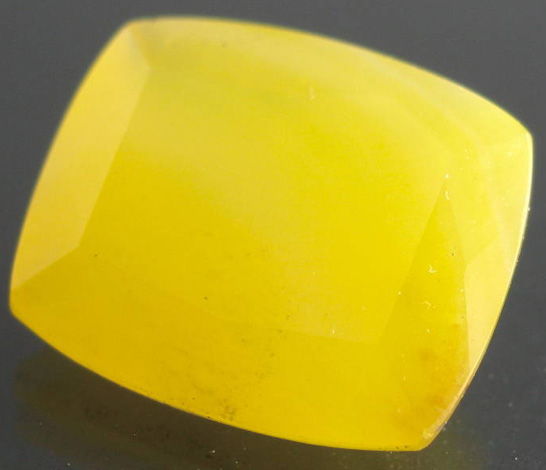Smithsonite

Smithsonite
(From Italy. Weight: 11.05 carats)
Image © supplied by Woodmansee* Gems

Smithsonite
(From Tsumeb, Namibia. Weight: 0.76 carats total for all 4 stones)
Image © supplied by Woodmansee* Gems
Smithsonite History & Etymology:
The gemstones of Smithsonite are extremely rare and are extremely sought after by gemstone collectors and gemstone experts. The first crystals of Smithsonite were discovered in 1832 by the famous British mineralogist and chemist, James Smithson. Smithsonite hence derives its name from its discoverer. Smithsonite was named in the honor of James Smithson after he distinguished the Smithsonite mineral from the other similar looking mineral, Hemimorphite.
Smithsonite Occurrence:
Smithsonite belongs to the Calcite group of minerals. This group also contains other minerals like Cobaltocalcite, Magnesite, Siderite and Gaspeite. Smithsonite is found in many localities across the world but gemstone quality crystals of Smithsonite are only found in the Kelly Mines in the state of New Mexico in USA.
The gemstones of Smithsonite yielded from the Kelly Mines in the state of New Mexico in USA are of extremely high gemstone quality with high dispersion that is almost as high as the dispersion of diamond. The largest gemstones of Smithsonite yielded from the Kelly Mines in USA weigh just a few carats.
Smithsonite Properties:
Smithsonite are composed of zinc carbonate and the dominant presence of carbonate classifies the Smithsonite mineral as carbonates mineral. Smithsonite belong to the Calcite group. Smithsonite occur in their natural form displaying trigonal and hexagonal scalenohedral properties. The Smithsonite mineral is generally uncommon as crystalline masses which are at least 10 cm in size.
Smithsonite which show rhombohedral or scalenohedral properties have curved faces and are sometimes stalactitic similar to cave pearls. Smithsonite can be granular as well as friable. Twinning though occurs in the Smithsonite crystals is rarely seen.
Smithsonite have perfect cleavages along with conchoidal to uneven fracturing which makes the Smithsonite crystals quite brittle. The Moh’s hardness for the Smithsonite crystals is between 4 and 4.5. Smithsonite in comparison to most rare gemstones are relatively dense with a density of approximately 4.4 g/cm3. Smithsonite do not exhibit properties of luminescence nor are they radioactive. The Smithsonite crystals however do show effervescence in warm and concentrated acids.
The gemstones of Smithsonite are available in a variety of different colors which vary according to the minerals included in the composition. The pink colored crystals of Smithsonite are typically due to the high percentages of manganese or cobalt in the composition while the yellow colored crystals of Smithsonite occur due to the inclusion of cadmium in the composition. Green and blue colored crystals of Smithsonite also occur which get their coloring due to the inclusion of copper in the composition.
The dispersion of the Smithsonite crystals is as high as the diamonds and the gemstones of Smithsonite can be easily faceted to have a beautiful silky and pearly shine. The exceptionally clear and bright crystals of Smithsonite are extremely sought after by the gemstone collectors and gemstone experts who are ready to pay hundreds of dollars to acquire this beautiful gemstone.
Back to the Gemstones List home page - over 160 gemstones explored!
Please feel free to link to this page - copy / paste the text below: (click to select)
Privacy Policy | Cookie Policy | GDPR | About This Site / Terms

© gemstoneslist.com 2018


